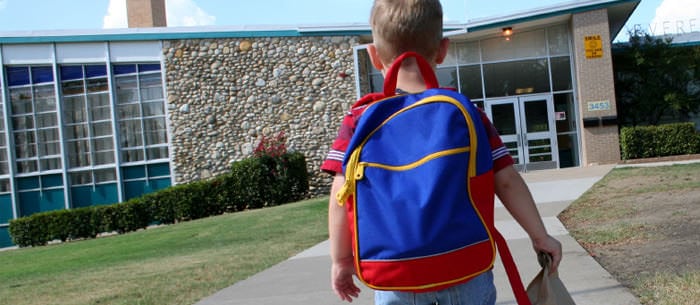The only constant for a military family is constant change, and school is no exception. According to the Military Child Education Coalition, “Military children generally move six to nine times during their K-12 school years.” This isn’t a small group of kids we’re talking about. There are 1.25 million school-aged military children. With military families moving an average of every two to three years, that means approximately 500,000 military kids change schools every year.
Let’s be honest, military children don’t have a lot of choice or control over their lives in general. For many kids — particularly as they get into their tween and teen years, the novelty of “starting over” tends to wear off. When you add in the stress of upcoming or recent deployments and the lack of choice in where and when they move, anxiety levels can spike.
As 15-year-old Maranda Valentine explains, “Your kids never signed up for the military. They never asked to be dragged from place to place.” It’s easier for the parents to look at the big picture and rationalize the sacrifices their family makes for a military career, but for the kids — particularly teens — it can be just one more thing to remind them of the lack of choice and control that comes with being part of a military family.
Rebecca Cleary is a Navy wife and mother of four who has moved six times with school-aged children. “My elementary school children would be weepy and sometimes have angry outbursts that had little to do with the situation we were in.” Her teens had a different response. “I just needed to give them space and let them grieve their old friends while still encouraging them to find new ones. They would either shut down and not express their feelings, or they would go to the extreme and let me know every day how the move ruined their life!”
A Mixture of Emotions
This displacement of emotion is completely normal, explains pediatric neuropsychologist, Dr. Jim Olsen. Some children may regress, others may become very clingy or distant. Some become angry and others overly sensitive. However, if a child is unhappy at their current school or location, or the new place offers experiences the child is particularly interested in, the move may be seen as a very positive change, says Dr. Olsen. In fact, many children rise to the challenge and see it as an adventure and take leaps forward in maturation during the move.
“With military families there are always unavoidable moves and that is part of the military life. As long as there are no significant underlying psychological issues, I believe most children will adapt,” says Dr. Olsen. (Read More about Military Families, Moving and Stress.)
The Achievement Gap
Dr. Olsen’s biggest concern is the difference in teaching methods and educational requirements that vary from school to school and state to state. It’s not just high school students who are affected. “The elementary school years are the most critical for children, particularly grades 1 through 3,” explains Dr. Olsen. “Many foundation skills are developed before the end of the third grade and it is important that children remain in the same educational format as much as possible during the formation of these basic skills.” He recommends finding out what language arts and math programs are used in your existing school so you can ideally find a new school that matches as closely as possible.
Cleary’s family understands the impact variant curriculums can have on kids. After one move, her two sons were enrolled in a school that used an experimental math and science program. “Their credits didn’t transfer because they missed the first semester and a half,” says Cleary. “We ended up keeping them back a year in fifth and eighth grade just to fill in the holes.”
Fitting In
“Uncertainty is the number one challenge for kids and the cause of most anxiety during the move,” says Dr. Olsen. “For children it tends to be related to self-esteem and friendships rather than educational requirements.” 13-year-old Emily Valentine, has moved schools every year since third grade. She says she always worries about making new friends and how she will be perceived.
Kids have different interests in different locations, fashions vary widely, and no kid wants to be the odd one out. “My biggest fear is not fitting in,” says 15-year-old Madison Cleary.
Getting your kids comfortable with their new community and school is the most important thing you can do to help your children says Dr. Olsen. (Read Sheila’s Blog Post about Fighting Bullying Peacefully.)
Using your Base
Dana Ledford has been a Command Ombudsman — the support and resource link between the families and a command — for six different Navy commands over the last 14 years. She recommends contacting the School Liaison Officer at your Family Service Center as soon as possible to help with the school transition.
Ledford also identifies other useful base-related resources. “The Welcome Aboard packet from your receiving command is a good resource for useful local information.” Ledford adds, “You can also contact the new base’s MWR to get onto their newsletter distribution list before you move.” She also suggests the school district website for useful information about school and community activities that are age-appropriate for your children.
“Plan to attend events occurring soon after you move so your kids have something to look forward to,” suggests Ledford. “Letting the child help plan an event or trip at the new location can help them feel engaged in the transition process.”
She adds that many Family Service Centers offer a “101 things to do in…” seminar that covers local — and not so local, activities in your new area. This may be a useful class to attend soon after you arrive at the new location.
Staying Connected and Moving On
Dr. Olsen recommends creating a photo book of favorite places and friends. Just the act of making the book with your child can be cathartic, and it also gives you the opportunity to talk with your child about their feelings.
Cleary says technology helps her teens. “YouTube has been a valuable resource for being able to see videos of the school’s football games, cheer and dance teams, special events and other videos that are posted under the school’s name. It’s a natural way for them to connect with the new school and get a feel for the student body.”
While the Internet is a great way to get connected before a move and also stay in contact with old friends, Cleary warns that overuse of social media can prevent the child from moving on and making new friends. She recommends getting children involved in activities over the summer with kids in the same school district so they will have friends at the new school before they start in September.
And after many moves Cleary gives perspective on it all.
“Moving can be an adventure and open the world up to the military kid. They see things in a bigger frame than the kids who have never been more than 100 miles from home,” says Cleary. “They learn to be friendly and open. They have more life experiences to draw from and can become more well-rounded than their civilian peers if they put a positive spin on their challenge.”
5 Websites That Can Help Smooth the Transition:
- Military Youth on the Move is a great resource for all school ages to help with the challenges of moving because of a military move.
- Tutor.com offers its homework help services free to all K-12 military children.
- Militarychild.org is the Military Child Education Coalition’s website and a wealth of resources for military families changing schools.
- Schoolquest.org provides information about all schools, state policies, credit transfers, and graduation requirements in all 50 states.
- Militaryonesource.org offers many information services for military families, but also has counselors available via phone 24/7 in case you, or your children, need someone to talk to. This is free and does not require a Tricare referral.






